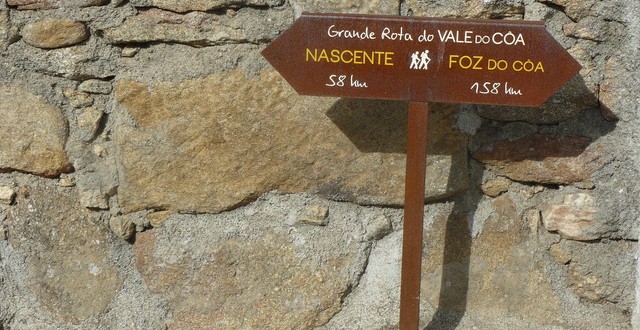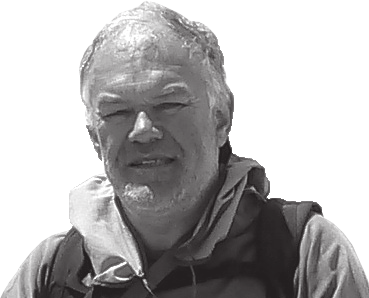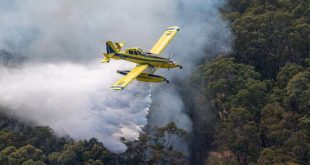I was on a journey and awoke at night, but I wasn’t sure to start with if I had already been asleep and dreaming, or if I hadn’t slept at all yet, whether dream and reality weren’t just two states that merged together and overlapped with each other? Somehow, images and voices had blended together in my subconscious. I turned the light on and looked at my watch. Five past midnight. Some drunks were mumbling away in the next-door bar. The yellow neon glow of a street light came through the blinds into the bare room, where I was trying to get to sleep on my bunk. Half asleep, I had marched through stony lunar landscapes, a river was meandering through a valley, a shepherd was walking over the burnt land with his emaciated animals. In this way I started to go through the days of my hike in my mind’s eye again, quite exactly, assembling the different days and images, and ending up with the following story. It started with three people meeting on a Monday in Lisbon, who wanted to travel by train to Guarda via Coimbra. The plan was to set off from there by bus and taxi to Foios, a small place at the source of the river Côa. The three had decided to walk to the mouth of the river. The woman and the two men had each packed a rucksack with weatherproof clothing, a sleeping bag, a water bottle, a compass, maps, emergency rations, first-aid kit, rain gear and a camera.
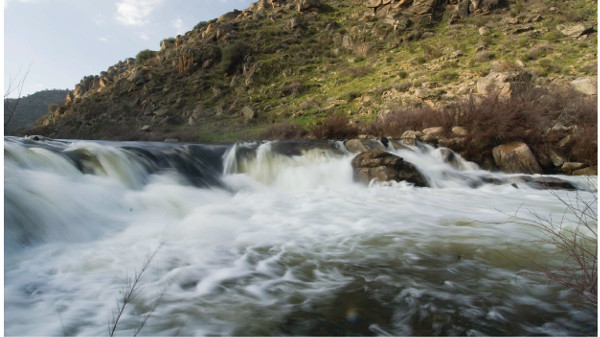
The “Grande Rota Vale do Côa” is 221 km long. Near the end, hikers are rewarded with stone-age graffiti in a 17 kilometre-long gallery that you can walk through in the open air. Aurochses, horses, deer, ibex, goats, fish… The footpath runs alongside the river and through the landscape to the rocks at Cidadelhe, Faia Brava and Vila Nova Foz do Côa until it flows into the Douro.
It is already late evening and dark when I get out of the taxi. We have arrived at last. Local councillor António Lucas, a short, well-built man in his late fifties, welcomes us in front of the one-time primary school in Foios. I haul my twelve-kilo rucksack out of the boot of the taxi and step into what feels like the end of the world. There are 30 camps beds in the classroom for three hikers. Clean sheets are to be found in a box in the hall, and there are two toilets just outside the building. It’s drizzling. António Lucas puts a bottle of drinking water by the door for us. The lodgings are free of charge.
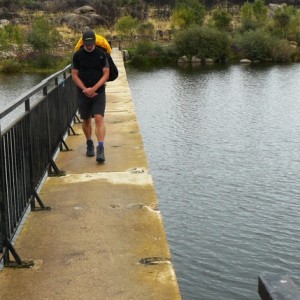
Tuesday. Day one. A wonderful, clean stream flows out of the source. We walk along tracks. Old chestnut and oak trees. 1,163 metres in altitude. It’s 25 km to the village of Quadrazais. At some stage we start to feel hungry. From Vale do Espinho, we have to walk two and a half kilometres along the tarred village road, which is not part of the walk. There we hit upon the trout farm Trutalcoa. The restaurant, which goes by the same name, has a varied menu with good prices. From there, we have to return to the tarred road and continue. It’s only when hikers reach the signpost to the Espirito Santo chapel that they get back on to the GR Vale do Côa. I have a dip in the whitewater swimming pool. As I dive in, the dark water swirls around my head and cools it nicely. I get dry, get dressed and set off again. We collect acorns and chestnuts. We have an appointment with the village elder of Quadrasais, Silvina Martins. She offers us accommodation in the empty primary school: three former classrooms. Beds? No, gym mats instead. At the Café “Santa Estefánia” next door, we order omelette and breakfast from Paula and Lourenço. The home-made pear cake for dessert is the high point of the day. We are woken by the cold at the crack of dawn. We are certain that the best days of hiking in Portugal are still to come.
Wednesday. Day two. The objective is Sabugal. Cool morning sunshine casts a somewhat pale light over the meadows and hills through which the river flows, with the footpath following alongside. Then the path leads uphill into the Serra da Malcata to Alto da Machoca. A viewpoint with an all-round panorama. Sweating and breathing in time with our steps, we climb up the 252 metres to the top. To the southwest, we can see the mountains of the Serra de Estrela on the horizon. To the north are the Côa reservoirs near Sabugal, to the east the Spanish border. The river is dammed here. Huge spits of land jut out of the water. The water depth gauge is very low because of the recent extremely dry summer. From the summit, the path leads downhill to the village of Malcata. There are seven carp swimming in the village fountain. The path leads away from the village to a beautiful picnic site with a chapel and then zigzags past the fringes of the reservoir as far as Sabugal. Another 25 km. Now the Côa is a river again. We take off our rucksacks in the hotel. While searching for an eatery of some kind, I stumble upon Carlos the barber, who cuts my hair.
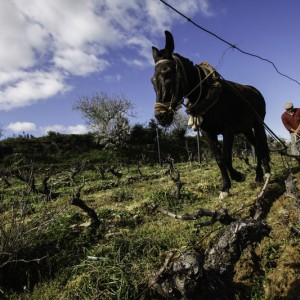
Thursday. Day three. The objective is Rapoula do Côa. In the morning, a fruit and vegetable market. Full of energy, we then follow the red and white signs leading out of Sabugal. We follow our noses, discussing the sense of beauty with each other, in completely the wrong direction. After two hours, we realise that the red and white signs on the footpath are not for our path but for another one. Now we’re standing in the forest. What next? Back to the babbling waters of the Côa and its winding river bed. We pick up the map, and reorientate ourselves. For an hour, we walk along main roads, tracks and farm roads. And then it’s there again, our river. A rest on the bridge by the water mill. We share bread, cheese, ham and the fruit. Autumn days. Indian summer. The path is full of leaves and cowpats. We come across ruminating, grazing animals on the 17 km long riverside path. Water mills and dark water, flowing slowly along. Shady paths and several gates that we opne and close again. The day ends at “Refúgio do Campo” with Dona Otília Inácio. She provides us with something that is becoming more and more precious. Peace and shelter. A lovely place to spend some time.
Each path is a story and paths connect people and places with their stories. People who travel on foot can feel how the woods, the weather, the river, the fields, hills, villages and the paths that lead there develop. With every step, one’s senses become sharper. Inner contemplation becomes part of walking. People who go walking find peace.
Friday. Day four. The goal is Vilar Maior. As far as Seixo do Côa there are abandoned ruins and church-towers clocks that have stopped. They only show the right time twice a day. Lots of new houses are unoccupied. Where are all the people? No children. Closed schools. Time has come to a standstill in the villages. Even the watchmakers have cleared off. If need be, you can use acoustic clues to guide yourself. On every hour, the loudspeaker on the church produces a tune. Like the muezzin. It pursues us day and night. Like the quadrupeds. We quickly learn that dogs that bite don’t bark. By the medieval customs bridge “Ponte de Sequeiros”, we rest. Cheese, sardines, bread. Fruit and chocolate. Then Badamalos. The castle of Vilar Maior is already in sight. Plaques beside the path commemorate two people who were run over on the road. António Cunha gives us a hearty welcome. He invites us to spend the night in the attic of the village hall. In Lisbon, they had forgotten his village, he tells us. There were many houses falling down. Just a few had been reconstructed under private initiatives. Lightning in the distance. Everything about this village, where 68 people still live, is like a film: the medieval bridge, the alleys, the church and the castle. Only the showers in the Caritas day centre for one euro fifty and the supper for six euros bring us back to the present day. 18 km.
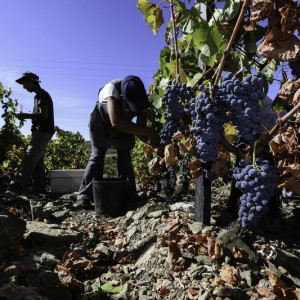
Saturday. Day five. It’s 22 km to Castelo Mendo. Thick cloud cover, being picked apart by the wind. The old cobbled road leads us back to the river. Continuing downhill firstly on the right bank and then on the left. The river slowly meanders northwards. Slowly we move away from it. The path goes under the tracks of the “Night Train to Lisbon”. Gardens with walnut and quince trees, vines and apple trees. The first drops of rain fall in the afternoon. A spectacular climb past cork oaks ends below the castle walls in the household waste of Castelo Mendo. We reach “Casa do Côrro”, a historic house which has been restored, largely thanks to public funds. No country for young people. I wonder what the future is for this village? The village pillory stands there below the church. Nicely restored. Old, sick people. “For sale” signs on the houses. But the house where we seek shelter welcomes us with cold showers, no bed linen and no drinking water. I sleep in my sleeping bag on the gap in the couch. We are given a plastic bag with bread, milk, butter and jam in plastic packaging. Closer observation reveals that the Dutch cheese comes from Poland. Shrink-wrapped turkey ham, a one-euro special offer. Poor Castelo Mendo. There are places that motivate you to keep walking.
Sunday. Day six starts with thick cloud cover and a 26 km walk ahead of us. Back down to the river. We feel our way along the bank towards Almeida, a once fortified town. Café Rio Côa, opposite the village of Castelo Bom, under the motorway bridge, an early bite: chicken soup, sandwiches and salad, which fortify us for the walk ahead. The GR Vale do Côa involves a daredevil climb over the slippery rocks along the bank before it switches from the left to the right bank. Something of a challenge as it turns out. It starts to drizzle. The “Manuel José” pedestrian bridge has no railings, they’ve been dismantled. The crossing is no fun for people without a head for heights. For a change there are some other people around: anglers. Walking over burnt earth. The riverbank is black. Nature is gradually turning into civilisation. The footpath turns into a track. The Côa changes its appearance, more like a canal than a river. We reach the hotel outside the town walls under our umbrellas. Squeaky mattresses, broken electric blinds that can’t be opened, thin walls that let the sound through, fairly run down, but a hot shower. A long bath in a sitting bathtub from the last millennium. Thus Sunday comes to an end. Half way. We’ve walked more than 120 kilometres.

Water simply splashes out and becomes a stream. Several streams become a river. Here and there a ford and a place to swim. In time, the colour changes, the waters become dark, accompanied by ash, chestnut and elm trees, oaks and poplars. Twilight hangs over the river. Slowly it flows on, becoming deeper, calmer. In the morning it steams, meanders like a snake through the landscape and deposits sediment in its bends. Here a weir, over which the water flows and behind which there is a home for fish and frogs. It becomes faster and then slower again. A grey heron stands for several minutes in the shallow water and contemplates its life. Then it flies off. Bushes with rose-hips and hawthorn line the route. The willows carve a still distant mountain landscape out of the evening twilight. The flat, sloping land close to the river becomes mountainous, and then flat again. The river is a reservoir of water. Then there’s a town and noise. The river changes its face, is serious, smiles, plays with its lips, turns up its nose. Sheep, cows and goats drink from it. The river provides cool, fresh water and carries away leaves, branches and other hidden messages. Here it shoots through the narrow landscape, there it flows more leisurely, in a wide bed. Here and there a rock and other rounded stones, like a head peeping curiously out of the river to see what is happening on the banks. No boats. But grass under the water and mosquitoes whirring over the surface. A world full of animals, mosses and lichen. As the clouds gather, its appearance changes again. A sense of joy develops and its aura eases. The bones of a dead animal are lying there. The skeleton on the edge of the river. Here a bare skull with teeth, there a bleached hip bone. It’s gone quiet. Not a person in sight. Wild dogs or even wolves? Natural landscape. Here and there an ancient water mill. Fertile, damp earth is encouraging for agriculture. Carefree nature, and the river again. Sometimes deep, sometimes shallow. Pale, unshapely driftwood, like polished bones from a grave in the occasionally dried out tributaries. Old obelisks, powerfully erected one beside the other, linked by yet more to form a bridge that leads over the dried out pebbles of the mouth of a stream. It starts to drizzle, just lightly as if experimenting, and then pauses again. Then drops form that fall on the ground, just here and there still. They hit the water like small bombs. At some point it starts to rain. A river is always patient with its sky.
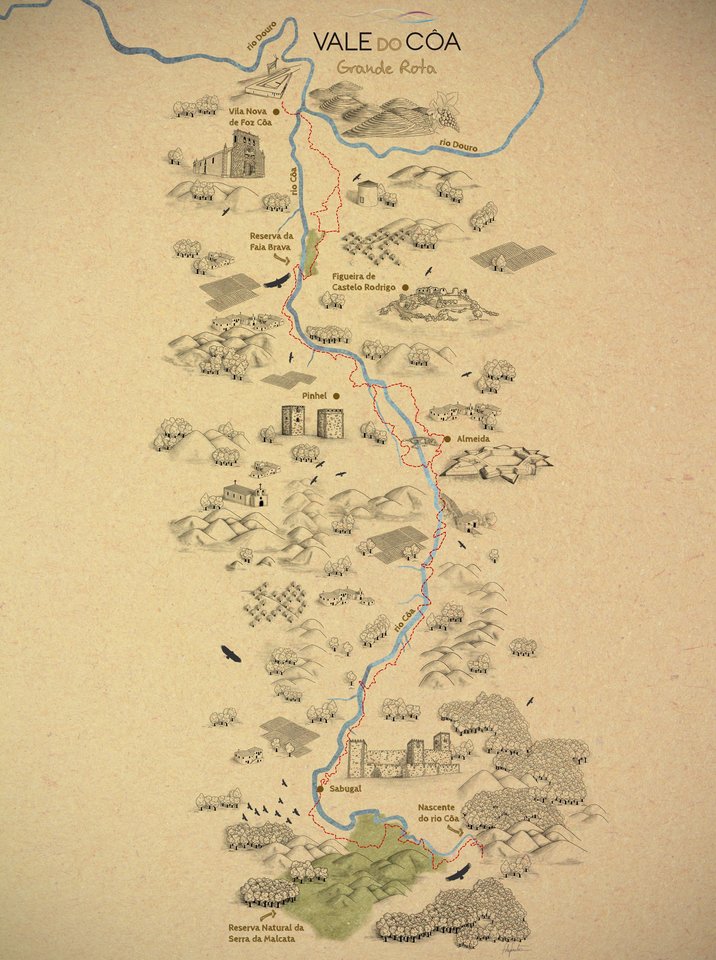 Monday. Day seven. We get up, have coffee, put on our rain gear, pull on our rucksacks. The horizon as black as chocolate. Only to the north there’s a tiny triangle, a little piece of light in the tunnel of the day, as if cut out of a tart. We set off from Almeida through the northern town gate and reach the suburb Arrabalde de Santo António. The road leads into a path to a farm and then our footpath is back. The day’s objective: “Quinta Nova” in the municipality of Pinhel. It starts to rain, and then to pour. One hour, two hours, and three. What has been in the offing for days has happened: the floodgates open. Steps in the sand, gravel, clay, on tar, scree and in long grass get harder and harder. Small streams form on the paths that run down to the river. Half way along the route there’s the village of “Cinco Vilas” with a café. Dona Fátima makes sandwiches with chouriço and tea.
Monday. Day seven. We get up, have coffee, put on our rain gear, pull on our rucksacks. The horizon as black as chocolate. Only to the north there’s a tiny triangle, a little piece of light in the tunnel of the day, as if cut out of a tart. We set off from Almeida through the northern town gate and reach the suburb Arrabalde de Santo António. The road leads into a path to a farm and then our footpath is back. The day’s objective: “Quinta Nova” in the municipality of Pinhel. It starts to rain, and then to pour. One hour, two hours, and three. What has been in the offing for days has happened: the floodgates open. Steps in the sand, gravel, clay, on tar, scree and in long grass get harder and harder. Small streams form on the paths that run down to the river. Half way along the route there’s the village of “Cinco Vilas” with a café. Dona Fátima makes sandwiches with chouriço and tea.
It was just a feeling. We were being observed. Something had moved there. But what? Finally I caught sight of the object in the landscape and zoomed in. A single cow grazing on the burnt black slopes on the other bank. There was nothing green for miles around for the ruminants. What’s she eating there? She must have escaped. She was standing there quite alone in the wilderness, moving carefully by the steep slope looking for the odd blade of grass.
The route changes from the right bank to the left. You have to balance carefully along a concrete weir. How can you do that if the river’s in flood? We are on our way to Quinta Nova, 24 km. Overnight in Encostas do Côa. Towards the evening, there’s a bit of light in the tunnel. Supper is served. Pumpkin soup, oven-baked fish, vegetables and potatoes au gratin, a 2008 rosé from Pinhel. “Creme leite” for dessert. Excellent. Just before going to bed, we hang our wet clothes up to dry. We stuff newspapers into our boots.

Tuesday. Day eight. The day’s objective is Cidadelhe. The sun has returned. The 26 km long path and the landscape become alpine. Our boots dry as we walk. Once we reach a height of 700 metres, the path zigzags down through a stony waste to 450 metres, where the Côa is dammed for electricity to be wrung out of it, then we climb up again to almost 650 metres, past plantations of quince trees. Harvest time. Women picking “marmelos”. Not a village for miles, so no lunch; only peanuts, student food, orange, apple, bread, cheese. Water’s beginning to run short. Our moods go up and down in turn. Sometimes we begin to flag; when the flesh becomes weak there are moments when the spirit threatens to weaken too. We’ll make it, I say. In Azevo, a village just off the path, a car mechanic fills our water bottles up again. We reach Cidadelhe high above the Côa as the light is fading. A six-bed room in the recently restored hiking hut “Cidadelhe Rupestre” awaits us. There are only 39 people still living in this marvellous natural and cultural landscape of stones. As if a giant had laid them at the edge of the footpath. Walls made of stones, stone paths, stone houses. UNESCO world heritage. We chew on history, boiled bacalhau and read Saramago.
Wednesday. Day nine. Cold but sunny. The weather is on our side again. We set off for Faia Brava and Castelo Melhor. 24 km. Nick from the ATN association in Figueira de Castelo Rodrigo collects us. We climb down a narrow path over rugged rock formations and into the Faia Brava nature reserve. We cross the river at the “Ponte da União“. In the autumn there’s hardly any water in it. We open the gate and close it again behind us: we see the wild horses and aurochses, walk through olive groves. A wild foal makes us jump and then blocks our path. It walks slowly around us wanting to get back to the herd, and neighs. Faia Brava is 850 hectares of pure nature. Vultures and eagles nest in the cracks in the cliffs above the river. We reach the association’s supply point. Lunch. We continue to Castelo Melhor via Algodres and Almendra. In the evening we have supper at the restaurant “Paleolitico”. The room provided by the parish is the only lodging in need. The muddled voices of drunks rise from the local bar.
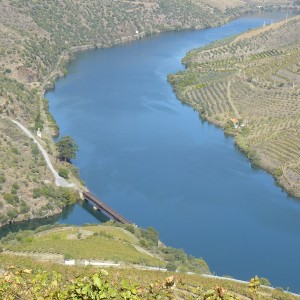
Thursday. Ten days walking downstream. The last 14 km to Vila Nova Foz do Côa. Up the hill, past vineyards and almond trees. The little white chapel at the top. Then the village of Orgal. The path leads directly to the Douro and then zigzags down through the vineyards to the mouth of the Côa. From far off, we can see our goal; the railway bridge at the river mouth and the town and its museum high up on the other side. We’ve covered 221 km. The final climb of just over 220 metres is the climax. There’s excellent local cuisine in the museum and plenty of cultural nourishment too. We greet the stone-age graffiti artists.
At the end, we meet Maria (69) and José (74) on their burnt plot. The two are sawing charred almond trees into firewood. I take an acorn out of my bag and give it to them. In the hope that we never have to bury our dreams and hopes again. We plant a tree or look at a 10,000-year-old engraving. In this way, we recapture the lost paradise for a moment. The two old people tell us that they had spent almost their whole lives living in France, working there like so many from this region. They had come back now to enjoy their retirement. But what was left of one’s own life and of the land when you had been away for so long?
 Eco123 Revista da Economia e Ecologia
Eco123 Revista da Economia e Ecologia

